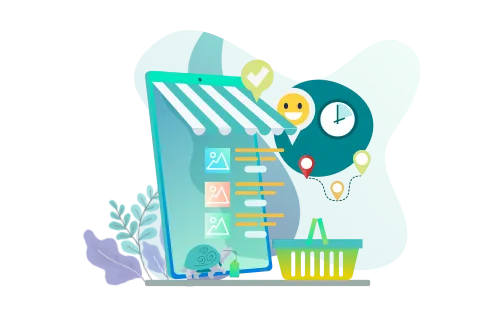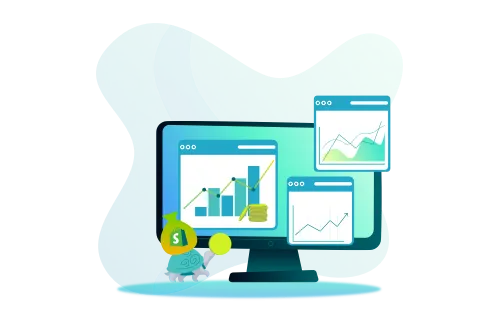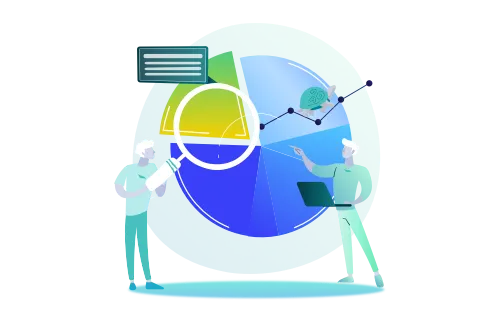A product page is where your store visitors will decide: to buy or not to buy. According to a Think With Google report, 85% of shoppers admit that product information and photos significantly affect their purchasing decisions. Unfortunately, a title, one or two images, a brief description, and CTA will likely not be enough to convince them.
Therefore, customizing your product page and expanding its content is crucial if you own a Shopify store.
But how can you improve product pages on Shopify, and will it help you convert those potential customers into actual buyers?
The GenovaWebArt team has deep expertise in Shopify solutions, including Shopify migration, custom features, integrations, and product page design. Find our works in portfolio. Drawing from our insights, this post explains the most critical components of the product page on Shopify, provides some helpful tips and inspires you with outstanding examples designed by our team. So, let’s find out how to organize products on Shopify.
Table of Contents
- Why Is It Important to Organize a Shopify Product Page Correctly?
-
What Should a Great Shopify Product Page Contain?
- The Product Title
- High-quality Product Images
- A Comprehensive Product Description
- Quality Product Videos
- Shipping Information
- Ample Customer Reviews
- Breadcrumbs
- 3D Models
- A Frequently Asked Questions (FAQ) Section
- An Add-to-Cart Call-to-Action (CTA)
- Subscriptions
- Upselling and Cross-selling Sections
- 3 Excellent Examples of Shopify Product Pages
- Additional Tips to Organize Product Pages on Shopify
- Start Building High-converting Product Pages on Shopify with GenovaWebArt
- Customize Your Product Pages on Shopify to Boost Sales and Increase Conversions
- Frequently Asked Questions
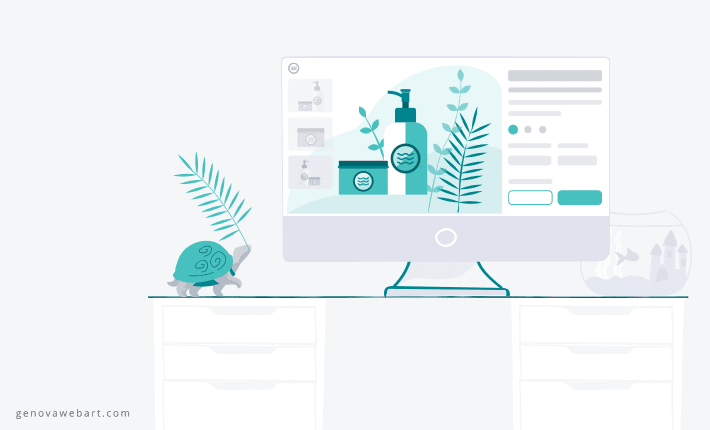
Why Is It Important to Organize a Shopify Product Page Correctly?
The visitors of your Shopify store won’t get closer to purchasing a product without a detailed description, high-quality images or videos, and complete shipping information. So when building or optimizing your online store, it’s worth paying extra attention to organizing your products in Shopify properly. Here are several key reasons why organizing products on Shopify matters.
- A product page presents your goods. When creating a website, you convey the value and benefits of the items you offer. If organized wisely and consistently, it will show how your product stands out and provide the shoppers with all necessary details.
- A product page presents your brand. Did you know that more than 50% of people google a product when making a purchase? Many have never seen the homepage before appearing on the product page. Hence, do your best to make it unique and help new visitors recognize your brand wherever they come from.
- A product page affects conversion rate. 55% of people spend less than 15 seconds on a web page. So each second is valuable. If you want to convert your website visitors into actual customers, find a way to create a Shopify product page that instantly makes people believe your product is worth it.
Read also: How to Create an Effective About Us Page on Shopify for Higher Conversions
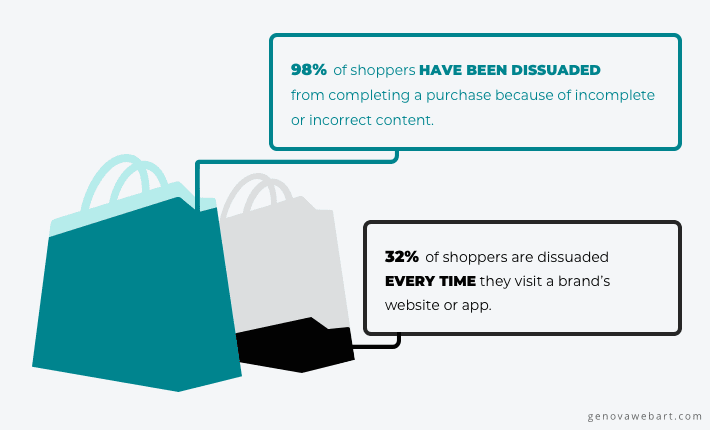
What Should a Great Shopify Product Page Contain?
As mentioned above, a product page template on Shopify consists of the basics like a CTA, brief description, and title. However, if you want to grow your eCommerce store and retain more customers, it’s worth customizing and expanding your Shopify store.
A good product page on Shopify should consist of multiple components that convey the item’s value and specifics to the customers. Here are the essential and optional elements you may consider adding to your product page.
The Product Title
Your product’s name is one of the most crucial product page components. Try to make it as appealing and informative as possible so that customers will understand the product’s key specifics once they look at its title. It’s also worth paying attention to the SEO keywords and optimizing your product names for search engines.
Most often, a good product name consists of the following elements:
- Brand
- Model or type of the product
- The product’s attributes or specifics (material, size, color, etc.)
Look at this product name in the Winky Lux cosmetics store. It instantly conveys all essential information yet isn’t wordy.
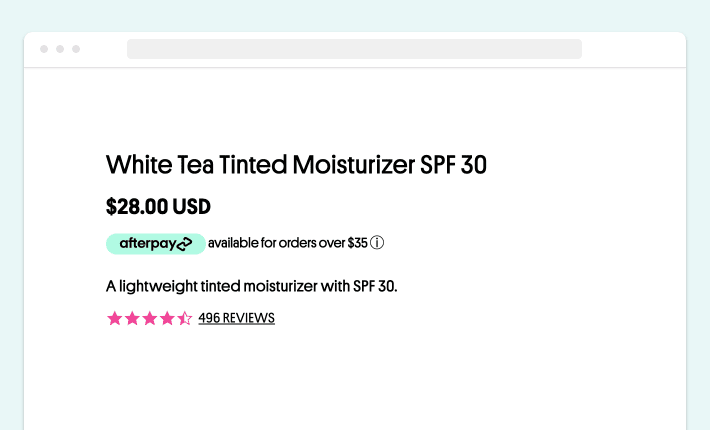
High-quality Product Images
The statistics claim that companies can reach a 7x higher conversion rate if using creative and engaging visual content on their product pages. And this is the case when it comes to Shopify product pages. Clear and appealing visuals will give your customers a better idea of future purchases.
Additionally, high-quality images are a great way to improve your SEO strategy and website ranking. That’s because search engines prefer to display good photos in search results.
Finally, remember that the product page images should be relevant to your goods’ features and characteristics. This way, you can enhance your customers’ trust in your brand.

Read also: Shopify Image Size Optimization in 2024
A Comprehensive Product Description
Product descriptions should be complete and detailed. Your customers expect to get all information about the item they’re interested in. Otherwise, they will likely start looking for more details elsewhere and may never return to your Shopify store.
The description specifics vary depending on your store’s type and target audience’s needs. For example, if you own a Shopify-based online restaurant, adding information about the meals’ calories and nutritional facts is essential. Or, if you run a cosmetics shop, focus on ingredients, shades, and colors.

Quality Product Videos
Video is a powerful marketing tool that can increase your conversions and significantly impact high-quality lead generation. What’s more, according to a Wizowl report, 94% of people prefer to watch an explainer video before buying a product or using a service.
That is why Shopify store owners often use embedded videos, AR technology, and 3D objects on their product pages, allowing their customers to have a more engaging shopping experience. Videos allow shoppers to immerse themselves into the product’s specifics and view the desired item from different angles.
Incorporating engaging videos into your Shopify lead magnet strategy can significantly enhance your customers' understanding and interest in your products, thereby increasing the likelihood of conversion.
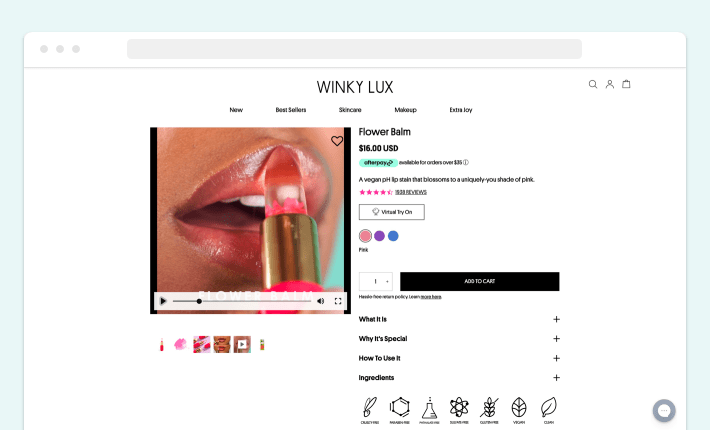
Shipping Information
You can arrange your Shopify product page so that people can find all essential information about an item in a single place. Thus, your website visitors won’t have to look for specific details regarding shipping and returns policy elsewhere. Such an approach will significantly streamline the user experience and allow your customers to make instant decisions.
Note that in Shopify Online Store 2.0, you can customize Shopify product page and change shipping details depending on the item’s specifics.
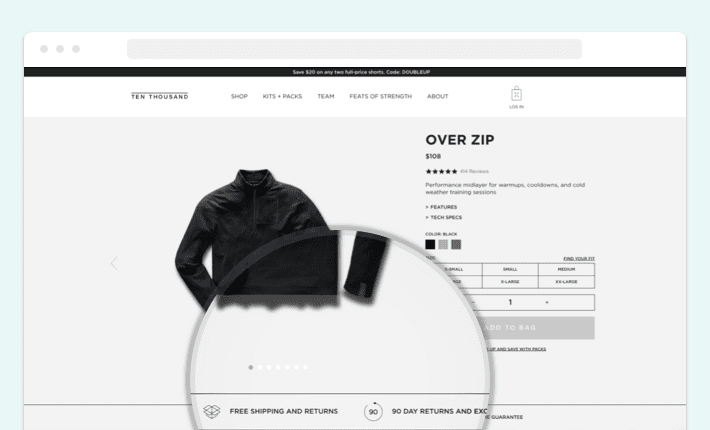
Ample Customer Reviews
According to a Trustpilot survey, more than 60% of people agree that customer reviews impact their willingness to make a purchase. Moreover, 88% of buyers trust product reviews as much as personal recommendations.

Besides, reviews and star ratings increase trust in your brand, give better insights into the product and boost conversions. They help shoppers better understand if the chosen item will match their expectations. As a result, your customers will make buying decisions faster and more confidently.

Breadcrumbs
If your Shopify store has multiple products and sections, consider improving navigation. You need to prevent customers from getting lost on your website. Otherwise, they may feel confused or frustrated, resulting in higher bounce rates.
Luckily, Shopify offers convenient breadcrumb navigation that allows users to move to other pages easily. Thanks to this approach, they can go back to your website’s higher-level pages or sections. Therefore, the shoppers continue their journeys from one product page to another without using the internal search or navigation bar.
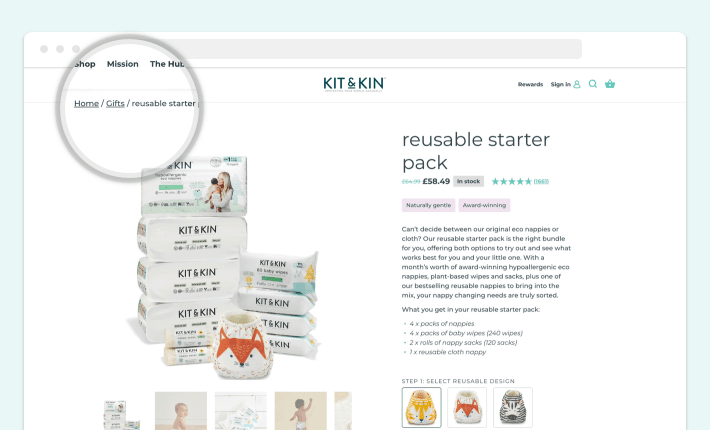
3D Models
Nowadays, 3D modeling is a powerful tool that may boost your sales on product pages and increase conversion rates by up to 250%. Why not deliver your customers a more engaging shopping process? Use a default 3D modeling feature offered by Shopify. In particular, merchants use this technology to introduce their goods on product pages.
A 3D model on your product page can provide your customers with a comprehensive idea of what your product is and how it looks. Moreover, it will make your store more competitive and enhance your Google ranking.
Learn more about implementing 3D models on Shopify.

A Frequently Asked Questions (FAQ) Section
Even the most detailed product description cannot answer all possible questions about the chosen item. So it’s a good idea to include a FAQ section when building your custom Shopify product page. If organized and implemented correctly, FAQs will allow shoppers to get the required information without turning to customer support.
Here are a few additional benefits you can gain if placing a FAQ section on your Shopify product page:
- Optimize SEO and navigation
- Earn customers’ trust
- Provide brief and creative answers to typical questions
- Prevent complaints and improve retention
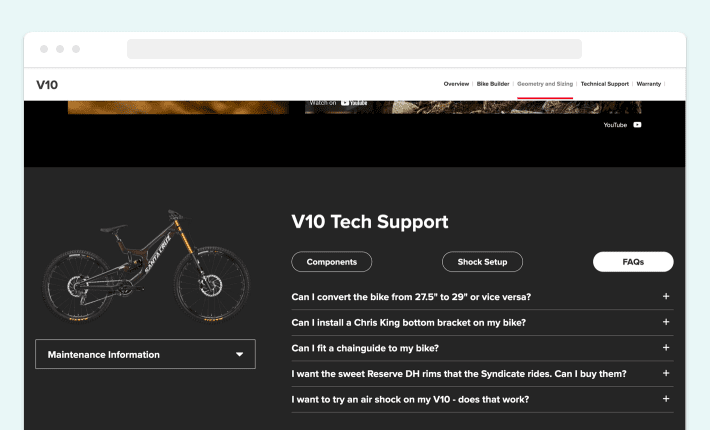
An Add-to-Cart Call-to-Action (CTA)
A Call-to-Action (CTA) button encouraging your customers to buy an item or add it to the shopping cart is one of the essentials on your Shopify product page.. Here are several tips to help you make your CTA instantly noticeable, clear, and appealing:
- Don’t beat around the bush. Your CTA should be understandable and concise. A simple “Buy now” or “Add to the cart” is usually enough.
- Make it eye-catching. Your customers should instantly notice the button, so ensure it stands out from the other content.
- Don’t make your customers scroll down. Instead, place the CTA on the first screen to make it visible to the visitors once they open the page.

Subscriptions
The popularity of eCommerce subscriptions has significantly increased throughout the last few years. According to a recent survey, it rises by more than 90% every year. On top of that, Shopify and Shopify Plus platforms allow merchants to implement subscription APIs to the product pages via a native app extension. Thus, you can do without third-party integrations and make the checkout experience more seamless. If you want to know how to customize the checkout page - read our detailed instructions for implementation on Shopify.
To learn more about setting up subscriptions on Shopify, check out our recent blog post.
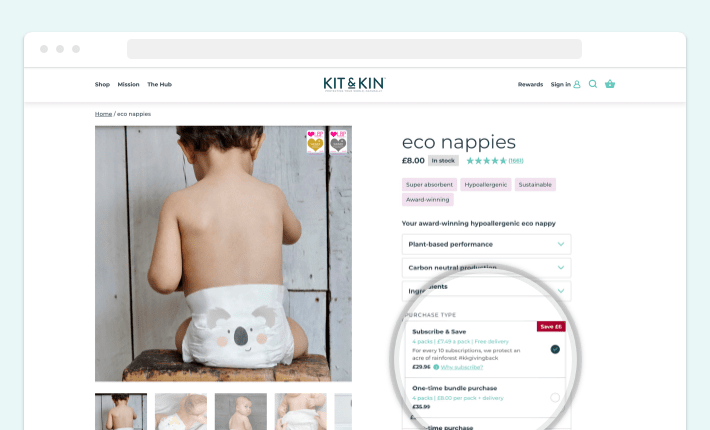
Upselling and Cross-selling Sections
Upselling and cross-selling are beneficial techniques that may help you encourage your customers to buy related or similar products in your Shopify store. Adding these features to your product page may help with the retention and average order value growth.
Let’s look at these additional options in more detail.
Upselling involves offering an existing customer to upgrade their purchase value by adding a more expensive item to their shopping cart. This technique can persuade a buyer to consider similar options presented in your store.
Cross-selling means offering products that may be relevant to the one a customer has chosen.
For example, if someone is purchasing a laptop, you may provide them with additional options, like speakers or AirPods.
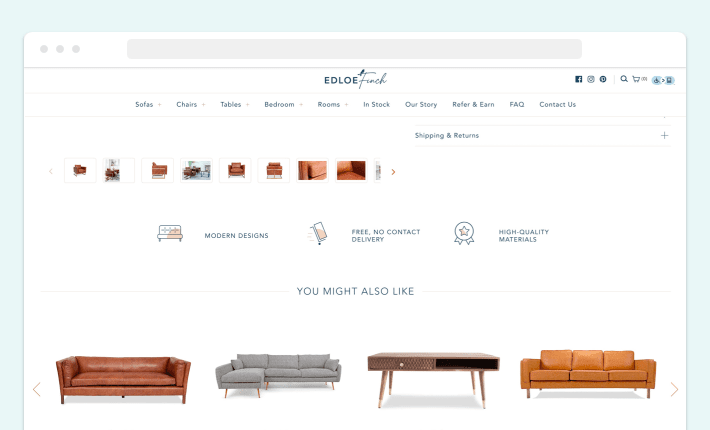
3 Excellent Examples of Shopify Product Pages
As you see, there are numerous things you can add or improve when customize your Shopify eCommerce store. Now, it’s time to get inspired and look at some of the best Shopify product pages.
1. Winky Lux
Winky Lux is a popular Shopify cosmetics store designed by the GenovaWebArt team. It offers numerous goods for skincare and makeup.
The store’s product page is intuitive and concise. It provides high-quality images and a demo video presenting an item. Also, you can find a brief FAQ section answering the most common users’ questions. Finally, the page contains all essential information about the product's benefits, customer reviews, and an ingredients list.
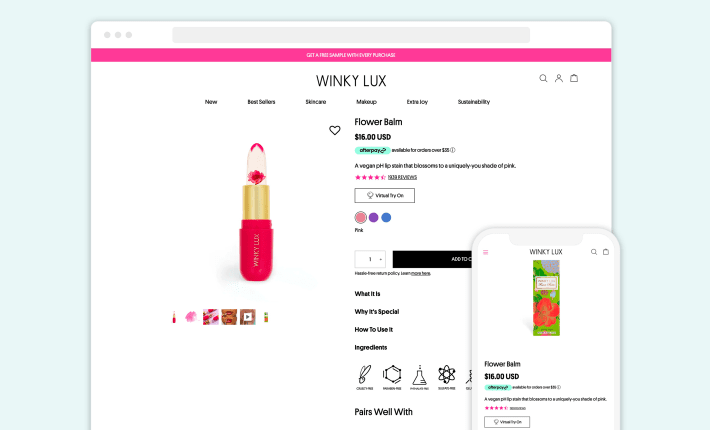
2. Kit & Kin
Kit & Kin is a brand offering natural products for kids, including eco nappies, skincare, and babywear goods. It allows customers to build their bundles and create subscriptions.
The product page on Shopify created by the GenovaWebArt team is well-organized and informative. It provides personalized images and videos, detailed descriptions, and a rich FAQ section for each item. You can also select the most suitable design and instantly access information about the ingredients, product benefits, care instructions, and size guides.

3. Ten Thousand
Ten Thousand is a sportswear store created by GenovaWebArt. It offers various categories of goods for workouts, exercise, and tourism. The shop also offers multiple kits and packs.
Product pages look clear and consistent. In the descriptions, you can find each item’s features and tech specs. Also, thanks to the cross-selling Shopify feature, the customers can see what a product may pair well with. Finally, the page contains customer reviews and information about the shipping and returns policy.
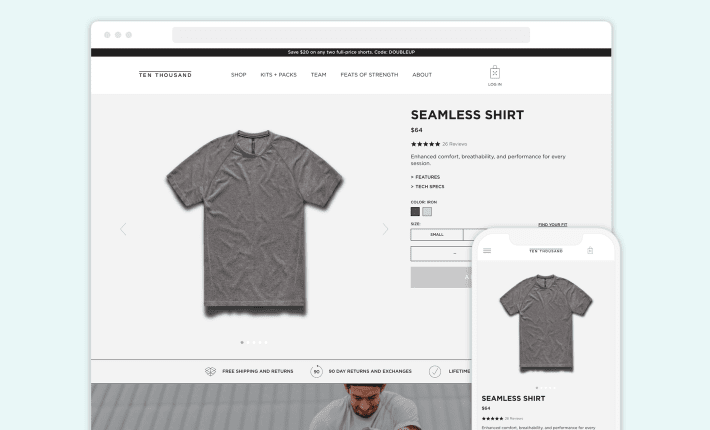
Additional Tips to Organize Product Pages on Shopify
So what exactly should you do to organize Shopify product pages effectively? Let’s look at the most valuable Shopify functions the platform offers.
1. Implement Features for Product Search and Grouping
It’s crucial to enable your customers to access convenient grouping and filtering options, especially if your Shopify store offers a wide range of goods. Such an approach will streamline the internal search and improve the shopping experience. Here are two excellent functions you can adopt to achieve those goals.
- Collections. This feature will allow you to divide similar products into separate groups. With its help, your customers can easily find goods with comparable characteristics.
- Tags. Adding specific tags to your product pages will make your store’s search more effective and intuitive. Your customers will be able to find the desired items without browsing manually.
2. Organize Your Products with Collection Function
As mentioned above, the collection feature allows merchants to arrange products in Shopify and significantly improves user experience. Here are several types of collections you can build depending on your needs:
- Basic collections. A simple collection allows store owners to group products based on their similarities. It’s a perfect choice for a midsize business offering a relatively small number of goods.
- Collections with discounts. You can create specific collections representing products with discounts within your promotional campaigns.
Thus, in order to understand how to arrange products on Shopify, it is enough to follow this advice.
3. Follow the Right Strategy
If you strive to sort products on Shopify more effectively, start with building a plan tailored to your business goals. The following steps can help you improve your customers’ shopping experiences and increase conversions.
- Prioritize your products’ specifics and types. Ensure your collections’ structure is consistent and improves user experience.
- Do comprehensive competitor research. Determine what methods and techniques other stores use to customize Shopify product pages.
- Conduct A/B testing sessions to streamline user journeys and make your online store more intuitive.
Start Building High-converting Product Pages on Shopify with GenovaWebArt
If you’re still not sure how to organize products on Shopify, start with examining your audience and try to understand what kind of shopping experience they expect to get. The Shopify platform doesn’t give a lot of freedom when it comes to basic themes and templates. However, you can turn to professionals like GenovaWebArt and work a miracle.
For instance, when working on the Kit & Kin baby products store, our team helped the company migrate from Woocommerce to Shopify. One of the key challenges was implementing custom collections and setting up subscriptions for primary and secondary product variants. Our team has managed these solutions and tailored Kit and Kin’s product pages to the client’s unique requirements.
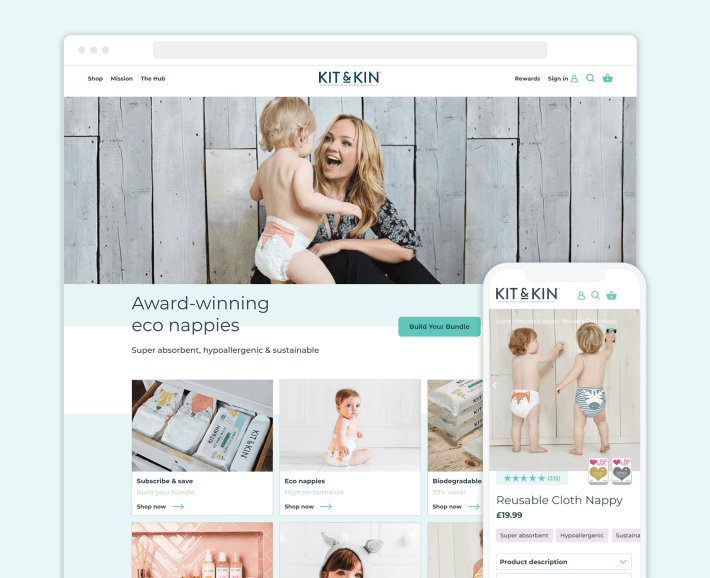
Customize Your Product Pages on Shopify to Boost Sales and Increase Conversions
Shopify product pages require a well-organized structure based on consistent planning. However, it’s definitely worth it if you want to enhance your customers’ shopping experiences, retain more users, and make your eCommerce brand stand out.
In contrast, a well-thought-out custom product page can provide the shoppers with all information they need, from detailed product descriptions and high-quality images to engaging demo videos and upselling offers.
Looking for an experienced tech partner to help you organize a Shopify product page? We at GenovaWebArt are experts in Shopify design and development solutions. Our team can provide you with stunning Shopify product page design, structurize your collections, and manage advanced integrations. Get in touch now to re-organize your product page that converts visitors into happy customers!


